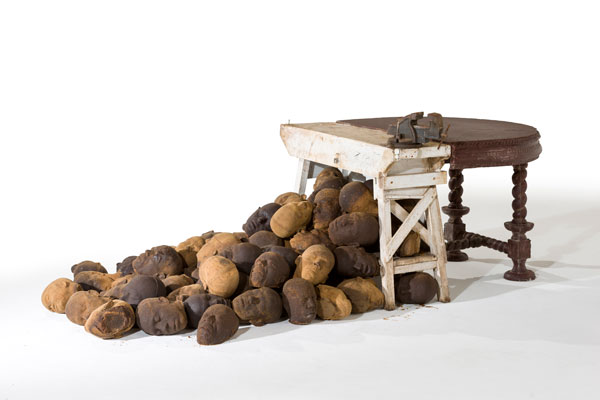In a 1994 Paris Review interview, the Nigerian writer Chinua Achebe famously quoted an Igbo proverb: “Until lions have their own historians, tales of the hunt shall always glorify the hunter.” In an exploration of the historical and contemporary complexities of the Afro-Brazilian state of Bahia, the Fowler Museum’s exhibition “Axé Bahia” seeks to tell that tale. The sweeping and fecund show begs for repeat visits, but a prevailing theme is immediately discernible: the deleterious effects of the African Diaspora on the body and soul of the enslaved, and the fervent attempts to reclaim both through the fashioning of a new, hybrid cultural identity.
Upon entering, Goya Lopes’ suspended silkscreened textiles beckon the viewer with vibrant colors and beguiling decorative patterns, but a closer look yields imagery such as whips and shackles, floggings, and diagrams of the slave ship. Like El Anatsui’s bottle caps and Yinka Shonibare’s Dutch wax fabric, Lopes’ textiles implicate capitalism in the desecration of African bodies. Caetano Dias’ striking sculpture, Delirios de Catarina (2017) also emphasizes the human costs of the slave trade, welding together half of an ornate dining table and half of a table where slaves labored, and piling dozens of black disembodied heads at its feet. The heads are comprised of sugar, and like Kara Walker’s A Subtlety, their alluring shimmer belies the bodily destruction such a crop effected.
One of the ways Africans in Brazil responded to slavery was through religion. Candomblé utilized aspects of West African religious traditions, including that of orixás, divine beings who intervened in the lives of mankind. Several artists engage with the famously secretive and oft-misunderstood religion: Ayrson Heráclito’s cerebral, large-scale photographs of the heads of men and women surrounded by foods that represent different orixás; José Adário dos Santos’ iron sculptures, emphasizing strength and virility; and Rubem Valentim’s Untitled (1989), a Constructivist-influenced abstract painting of signs and symbols, all suggest the richness and potency of the tradition and how it facilitated world-building.
The focus on the mind and soul is matched by dynamic movement and presence of the body. Several works, such as a film by Alexandre Robatto Filho, portray capoeira, a dance/martial art form derived from African choreography and native to Bahia. Pedro Marighella’s striking painting from his Série Mata (2014) shows a roiling crowd of people at Carnaval, their physical forms overwhelming the heterotopic space they occupy.
Significantly, some artists contend that Afro-Brazilian bodies are still subject to abuses and policing not unlike slavery. Rommulo Vieira Conceicão’s sculpture evokes a barricade or fences around a prison or housing project, and Tiago Sant’ana’s video mourns murdered youth in the Cabula neighborhood. Fittingly, as the exhibition is arranged in a half circle the last piece the viewer sees was also the first: Heráclito’s Divisor (2017), a large glass vitrine filled with salt water and blood-red palm oil, the latter thickly and sinuously resting on top of the water. The simultaneous melding and separation of the two elements is an evocation of the Middle Passage and a metaphor for the Afro-Brazilian experience.



